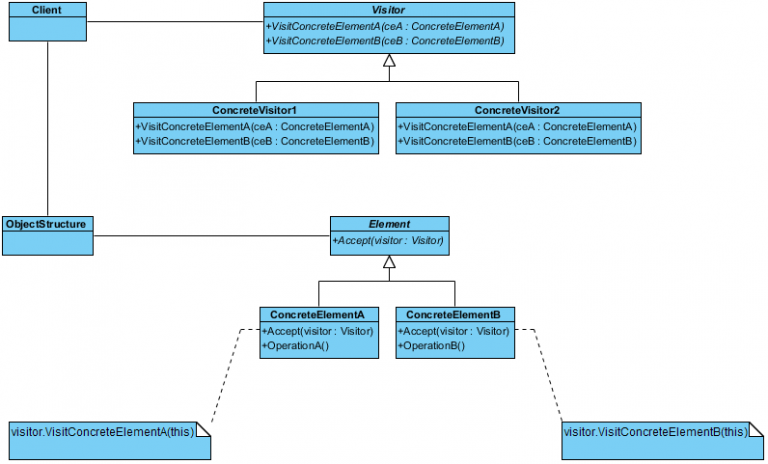Table Of Content

Design patterns differ by their complexity, level ofdetail and scale of applicability. In addition,they can be categorized by their intentand divided into three groups. Provides the ability to restore an object to its previous state (undo). The example shows a Contact manager that provides the ability to restore a person’s original identity through hydrate/dehydrate methods. Provides an interface between two unrelated entities so that they can work together. This is done by wrapping an interface around an already existing class.
Proxy
They state that applications are hard to design, toolkits are harder, and frameworks are the hardest to design. Sometimes acquaintance is called 'association' or the 'using' relationship. Acquaintance objects may request operations of each other, but they are not responsible for each other.
Pattern Name and Classification

This was a long one so congratulations if you made it this far. It is very likely that you don’t have to apply all of the patterns but just a few of them, nonetheless it is reasonable to know their existence. Besides, you can always come back to this post to refresh your memory when needed. Turns a request into a stand-alone object that contains all information about the request. This allows for deferred or scheduled execution of operations, queuing of operations, and undo/redo.
Finding Appropriate Objects
New classes can be defined in terms of existing classes using class inheritance. When a subclass inherits from a parent class, it includes the definitions of all the data and operations that the parent class defines. The second criterion, called scope, specifies whether the pattern applies primarily to classes or to objects. Class patterns deal with relationship between classes and their subclasses. Object patterns deal with object relationship, which can be changed at run-time and are more dynamic. There are 11 behavioral design patterns defined in the GoF design patterns.
You can write a problem statement and create classes and operations. Or you can model the real world and translate objects found during analysis into design. Design Pattern — Elements of Reusable Object-Oriented Software book describe design patterns using a consistent format. Each pattern is divided into section according to the following template. While you could build strategies in Go using single-method interfaces, that's not very idiomatic. You're better off defining a function signature and having each algorithm being a function that implements the same signature.
Common terms and phrases
There are 7 design patterns in the Structural Design Patterns category. There are 5 design patterns in the Creational Design Patterns category. In this example, the Context class holds the current state and can change its behavior by changing the state. The ConcreteStateA and ConcreteStateB classes are two concrete states that handle requests differently. The CurrentConditionsDisplay class implements the Observer interface and is used to display the current conditions.
GoF Design Patterns Using Java (Part 2) - DZone
GoF Design Patterns Using Java (Part .
Posted: Wed, 08 Feb 2017 08:00:00 GMT [source]
Designs used in the creation
A perfect example for this pattern is a tree structure, where nodes or leaf objects are use to build up more complex results. Façade provides a wrapper simplified interface to a large portion of code. It is often present in systems that are built around a multi-layer architecture. The next example shows how 3 subsystems are used to validate an insurance request. In my previous post, focused on Architecture patterns, I commented on the difference between those and Design patterns, which are the ones we will dig into next.
You build a decorator by creating an object that wraps another but has the same methods and forwards calls of these methods to the object being decorated, adding some functionality on top of them. Instead of thinking about factories as classes you use or extend, you can have them be a function you call that produces the object. There is no need for inheritance, abstract classes, or interfaces, just a function signature. We need mocks for net.Addr and net.Conn as we want to return in memory structs for those.
Java Object Class
This gives the program more flexibility in deciding which objects need to be created for a given case. Acquaintance implies that an object merely knows of another object. Sometimes acquaintance is called “association” or the “using” relationship.
Provides an object that acts as an intermediary for accessing another object. A proxy is used to control access to an underlying object, by providing a surrogate or placeholder for the real object, for example, to add security or caching. When I see patterns in my programs, I consider it a sign of trouble. The shape of a program should reflect only the problem it needs to solve. Consider the distinction between object aggregation and acquaintance and how differently they manifest themselves at compile- and run-times. Aggregation implies that one object owns or is responsible for another object.
In other words, it provides an interface for creating families of related or dependent objects without specifying their concrete classes. Inheritance and composition each have their advantages and disadvantages. It also make it easier to modify the implementation being reused.

No comments:
Post a Comment